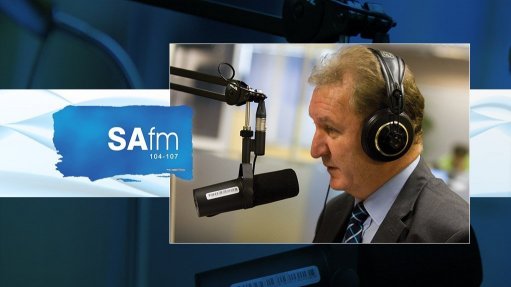
Every Friday, SAfm’s radio anchor Sakina Kamwendo speaks to Martin Creamer, publishing editor of Engineering News & Mining Weekly. Reported here is this Friday’s At the Coalface transcript:
Kamwendo: South Africa needs to get going fast on building the 88 infrastructure projects chosen this week by the Presidency.
Creamer: It is an amazing sentiment we have in South Africa at the moment. It is this sentiment of unity. The Presidency called people together, under this particular SIDSSA scheme of the Sustainable Infrastructure Development Symposium of South Africa,. There was amazing consensus that infrastructure investment is the only way to propel this economy forward.
That was economists, bankers and other people involved in investments coming together and saying that investment in productive infrastructure is the only way to propel the economy forward. There were three funding options that they were looking at for these 88 projects, and that’s a lot of projects. Some of these will go ahead using private sector funcing alone, because they are best suited for the private sector to do so in terms of risk. For other projects, the risk paradigm is such that it is best for the government and the private sector to work together on these projects. Then, there is the third category of projects where it is best for governments to go ahead on their own.
The big call was ‘hurry up’. This is what the sentiment was. We need to get cracking on these projects, to move ahead at speed, and the other call was for complete transparency. They are saying that the worst thing that can happen now is that the funding comes through at too high a price. You must not overpay for funds when you go into these projects, was the strong message, and the funding must be obtained with return in mind. There is a lot of vigilance, a lot of consensus and unity on how South Africa can try and create a V-shaped recovery. We all want a V-shaped recovery, to at least get back to where we were, which wasn’t that good, anyway, as we entered the pandemic during an economic ebb.
Kamwendo: Lesotho has opened more border posts to speed up the return of foreign mineworkers.
Creamer: There has been tremendous congestion at the border posts, because the whole system of coming through has changed with Covid-19. You had mineworkers formerly coming through in groups, with forms signed by individuals, now each mineworker is having to come through as an individual and conform to strict protocols. Then there are police regulations that have to be adhered to on the other side. You have to provide all sorts of paperwork and police tell you what route to take to come through to the mine.
They have to have guarantees that there are people at the other end to receive you at the mine and who will put you into quarantine. It has been a heck of a hold up. There was only one border post for 12 000 mineworkers returning from Lesotho. At least they have now created two more, so that there are now three border posts, and it is starting to move better. But, there is still only one border post for mineworkers returning to work from Mozambique.
There are fewer mineworkers coming through from Mozambique, 4 000 mineworkers, a third of the number that need to re-enter from Lesotho. It is still slow but at least consensus has been reached and structures have been set up. We should see more foreign mineworkers returning to South Africa’s mines in the upcoming week.
Kamwendo: Six mineworkers working on South African mines have now died from the coronavirus.
Creamer: Yes, this was announced yesterday by Minerals Council South Africa. We have been meeting weekly with Minerals Council South Africa and they have been giving us statistics, but this time round, it came with statistics on Covid deaths. We see six deaths, three of them from the platinum sector, which employs most mineworkers, and two from the gold sector and one from other sectors of mining.
Mines are trying to increase this Covid testing capacity because there are generally too few testing machines, too few kits and too few qualified staff. Some of the mines are setting up their own testing facilities on their own mine sites to speed up the processing of tests and they are coming together and making sure that if it is in the North West province or Limpopo province, the mines work on a regional basis, just to try and make sure that they can do this in the most efficient way and get test results back quicker. More than 17 000 tests have now been conducted for the 272 000 workers who are now back at work, and who are being screened daily.
Kamwendo: Thanks very much. Martin Creamer is publishing editor of Engineering News & Mining Weekly.